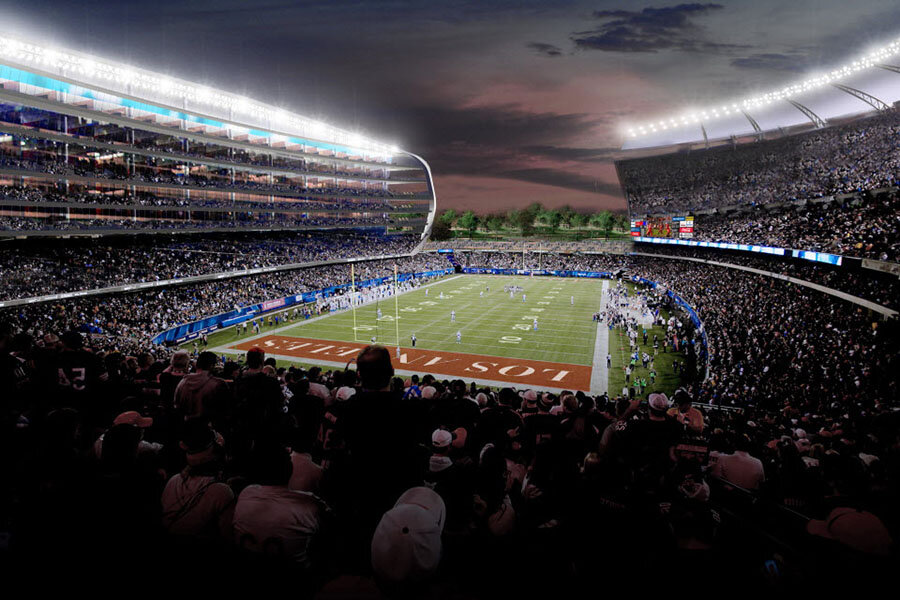Carson is latest to try to return professional football to Los Angeles
Loading...
| Los Angeles
Cheers went up from jersey-clad football fans when the Carson City Council unanimously approved a privately-financed stadium for the San Diego Chargers and Oakland Raiders Tuesday night. At first glance, the deal ostensibly approves a new, $1.7 billion stadium in Carson, giving a new and shared home to both teams.
But a host of national football and sports business analysts are quickly chiming in to admonish them not to spike that football in celebration just yet.
A possible deal to bring a National Football League franchise back to the nation’s largest city has been percolating in the local press for months. However, competing projects are also being proposed in several other locations. And because a 26-page initiative petition details a complex plan with a three-way land deal between property owner, the city of Carson, and Charger owners analysts say there are many ways the stadium could be derailed.
“Details, details, details. Who is going to pay for construction? Who is going to pay for infrastructural updates [and] any existing bonds in St. Louis, San Diego, and Oakland?” asks Rick Eckstein, Villanova sociology professor and author of the book, "Public Dollars, Private Stadiums."
He and others say it is possible that either the Chargers or Raiders are trying to create leverage for stadium improvements in their own cities. St. Louis is weighing a similar project. Carson isn't even the only community in the Los Angeles area interested in hosting the new stadium; the city council in nearby Inglewood voted to OK a similar plan in February.
A host of issues will have to be hammered out before any deal could come close to being finalized.
“Who will pay for cost overruns? Who gets the revenues from parking? Who gets tax abatements or favorable [pilot transfer] arrangements?” Professor Epstein asks. And “how much economic activity will be diverted from other county entertainment sites?”
Perhaps the most onerous issue revolves around who would foot the bill for the project. Although the agreement pledges that no tax dollars will be used, analysts say the city could be on the hook for such upgrades as freeway exits and parking.
“There is a lot of skepticism to be had about all of this, not the least of which has been the express-train speed with which this has been decided,” says Mark Conrad, director of the sports business program at Fordham University in New York.
He notes that 24 of 32 NFL team owners have to OK the deal – a vote not taken until January 2016.
“The NFL does not want angry fans on its hands,” he says, noting the possible sensitivities from residents in both cities who would not only lose a prestigious team, but might be stuck with other financial liabilities for the aging stadiums left in both cities. “This has been a real soap opera,” Conrad adds.
All this being said, the return of an NFL franchise to the nation’s second-largest city after 20 years of absence, would be a real reason for celebration, for many, analysts say.
“This would be a huge feather in the cap for Los Angeles in terms of having the NFL pedigree in a city that has multiple world champions in both hockey and basketball,” says Dan Lebowitz, director of the Center for the Study of Sport in Society at Northeastern University. “And it would be a new kind of draw for younger players who are attracted by the cache of living in the entertainment capital of the world.”
But that cache might also require more cash, says Frank Shorr, director of Boston University's Sports Institute. After having season tickets to the New York Giants since 1962, he suddenly received a $20,000 bill in the mail for the same four seats when the team moved to a new, $800 million stadium in 2005.
That practice, known as “personal seat licenses,” entitles the holder to buy season tickets for a certain seat in a stadium. The practice is used by 16 NFL teams and a handful of NHL and NBA teams. PSLs are projected to account for about half the cost of the new, Carson stadium.
At this point, both sides are touting advantages in the press.
One consultant for developer AECOM has projected a one-team stadium would boost city revenue $800,000 the first year and $168 million over 40 years. But a city-funded report released over the weekend also drew attention to lack of detail: “As of the date of the completion of this Report, no official project design documents have been provided by the Stadium Developer,” it said. The report also raised concerns about finding an additional 16,000 off-site parking spots and construction noise.
From a business perspective, the deal so-far appears to be "very convoluted and not very transparent," says Jason Maloni, a crisis communications professional at the litigation firm Levick.
“I’ll believe an NFL team based in Carson when I see it,” he says.







